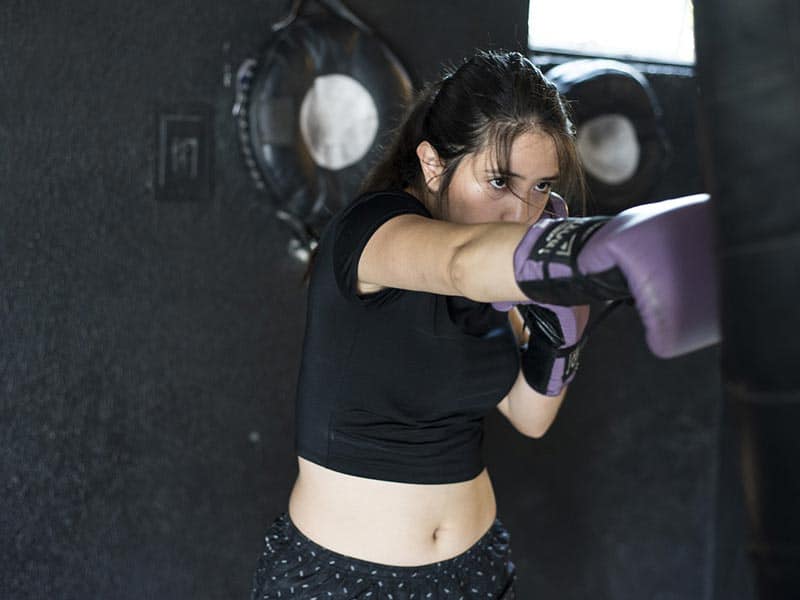Can You Get Ripped From Boxing?: Doesn’t everyone yearn for a well-sculpted body? A physique so aesthetic, that it makes you look like a Greek god? A ripped body! Yes, it’s possible to attain such a structure. All you need is a little hard work and dedication and you’re on your way to get ripped!
But we’re not talking about the regular ripped body, we’re talking about how you can get ripped from boxing. We’re talking about wearing gloves and throwing punches at your opponent or a punching bag and getting a chiseled look in return.

Inspiring your journey, one story at a time. #LifeFalcon.
I know makes you wonder, how boxers build muscles without lifting weights.
All this may seem simple and effortless, but it doesn’t come easy. To achieve a ripped body, you need less fat and more muscle. Boxing combined with strength training exercises helps you reach your goal. How does it work? Well, strength training helps you build muscle and boxing helps you lose fat.
Therefore, when you start losing body fat, the muscles start showing themselves, leading to a ripped look.
As you read on, you will learn about all the things you need to do to get that ripped body through boxing. The workouts, the exercise routines and meal plans followed by renowned boxers, that will help you to get that perfectly sculpted body.
Table of Content
Famous Boxers

When we talk about boxers with a ripped body, a few names immediately come to our minds like Floyd Mayweather, Mike Tyson, Sugar Ray Leonard, Rory Jones Jr and Evander Holyfield.
All of them have amazing physiques.
They are professional boxers and it’s their job to train and fight. In order to get a body like them, you need to train like them and focus on your ultimate goal – a Greek god-like ripped body!
So let’s take a look at some guidelines to start training for the ideal look.
Strength Training

As I mentioned earlier, incorporating strength training with boxing is the best way to get a ripped look.
But can you rely solely on weights for strength training? The answer is no! You need to include other routines to your strength training regime, like medicine balls and body-weight exercises.
Medicine balls are all-rounders as they help in working on different areas of the body. Following are examples of two different exercises that can be done with a medicine ball.
- Medicine Ball Squat Throw
In a medicine ball squat throw, you have to perform the regular squat by holding the medicine ball in both hands. As you move up, you have to throw the ball upwards as high as you can, and then catch it while going down in the squatting position. This helps to strengthen your core and arm muscles.
- Medicine Ball Push-up
A medicine ball push-up is just like a regular push-up with a twist. You simply have to place the medicine ball under one hand, while the other hand is placed on the ground. As you perform the push-ups, you roll the ball from one hand to the other. This is kind of a strenuous exercise because you need to focus on keeping yourself stable during it.
Circuit Training

Adding high-intensity aerobic workout to your strength training regime, helps you burn fat, gain muscle and boost your endurance. Circuit training includes the following workouts:
- Push-ups
- Pull-ups
- Burpees
- Weighted punches
- Jump rope
- Kettlebell swings
- Tire flaps
You have to select any five exercises for your circuit, 90 seconds per exercise with a 30-second rest between reps. You can either set the number of reps you have to do or try doing as many as you can within the 90 seconds. Repeat it three times.
Weekly Workout Plan

Once you’re mentally and physically prepared to get on with your training, it’s time to set days for each kind of workout. Ideally, it is said that a 2:4 ratio should be followed every week in your exercise regime. This means that you should dedicate 2 days of the week to strength and muscle training and 4 days a week solely for boxing. This leaves one day to rest.
- Warm-up
Before starting any exercise, a warm-up is a must. Start by jogging or skipping rope. This should be followed by rounds of punches including jabs, uppercuts, and hooks. As you progress, you should increase the intensity. A warm-up should usually end with 50 or 100-meter sprints.
During the boxing days, you should practice shadow boxing, hitting the punching bag, and hitting focus mitts. These are strenuous cardio exercises, which will burn the fat stored in your body and give way to the muscles so that your body cuts and creases become visible with time.
This was just a rough idea of how to get about these exercises. Professional boxers follow proper strength and circuit training routines and workout for 3 to 6 hours each day, every day.
Get a Boxing Partner

Doing any activity alone can cause boredom, lack of interest, and demotivation. To cancel out all these things, what you need is a boxing partner. Ask your friends to train with you. If not, find someone at the gym who would gladly partner with you during the workout sessions.
Having a boxing partner helps you improve your technique and reduces the chances of injury that might happen if you’re on your own. Workouts can become more challenging with a partner controlling the pace of the boxing pad rather than hitting a punching bag that moves according to the intensity of your punch. It takes you out of your usual comfort zone and you try harder to match the speed of your partner.
Having a boxing partner makes workout sessions exciting and challenging and you look forward to them.
Food and Nutrition

When you opt for boxing to achieve a perfectly ripped body, you have to take care of what you eat. It is recommended to include whole foods in your diet. Whole food includes lean meat, fish, chicken, lots of vegetables, and nuts. Carbs like rice and potatoes can be taken in moderation.
The logic behind consuming whole foods is that they have fewer calories but keep you fuller for longer. If you eat junk food, it will have a high-calorie count and won’t fully diminish your hunger. Therefore, switching a 1000-calorie burger with something healthy like spinach, rice, yogurt, and chicken will give you a whole lot of variety in the same amount of calories or less. Also, it will keep you full and benefit your body.
Sugary and fatty foods should be kept to a minimum and can be replaced by protein shakes and nutrition bars, to keep your sweet tooth happy.
All in all, taking all food groups in moderation is the key, not only with regard to boxing but to stay healthy in general.
A Day in a Boxer’s Life

Now that we have covered the basics of what one needs to do to get a ripped body by boxing, we will take a look at the life of a professional boxer. How do they start their day? What do they eat? How many hours do they spend on training? How many hours of sleep do they take every night? All these questions answered, to give you an idea of how you can manage everything even when your hands are full.
26-year-old professional boxer Chantelle Cameron (a British boxer) told about her typical day. (Image above)
- Sleep
According to Chantelle, sleep is very important to help your body in recovering from the day’s stress. So she always tries to get 8+ hours of sleep each night. Going to bed around 11 pm and waking up by 8 am is her daily routine.
- Morning Training Session
After waking up, Chantelle goes for a steady run on an empty stomach. It usually lasts anywhere from 30 minutes to an hour. This kick-starts her day.
On days when she doesn’t go for a run, she trains later in the day. This session consists of strength and conditioning or sparring and is almost 45 minutes long.
- Breakfast
Her breakfast is usually light – eggs, porridge and a coffee. Having a light breakfast means you can have a good lunch, to balance out the meals.
- Lunch
For lunch, Chantelle prefers to have a protein-filled meal, consisting of chicken or fish with a variety of vegetables. She also throws in some carbs because lunchtime is recovery time from all the training she did earlier in the day.
- Post Lunch Routine
Once she’s done with lunch, she relaxes a bit to get ready for her second training session. She watches TV or goes shopping to unwind and also so that her food gets digested before her next session.
- Second Training Session
Chantelle’s second training session in the afternoon consists of sparring, pad work or strength and conditioning. She keeps a considerate amount of gap between her lunch and training session as it is difficult to workout on a full stomach. But she has a coffee or some nuts before it.
- Recovery
So much training leaves Chantelle’s body sore and her muscles aching, for which she gets a massage. It helps her body to recover so that she can get her workout done. She gets her massage usually before her second workout or later in the evening, after she’s done with both the sessions. It all depends on how her day pans out.
- Dinner
Chantelle makes sure that her training sessions end before 7 pm, because after that she has dinner and relaxes for the evening.
Her dinner doesn’t include carbs, only meat or fish with loads of vegetables.
- Ending the Day
Once she’s done with dinner, she goes to a spa centre for a nice relaxing hot tub, sauna and steam. This is much-needed relaxation after such a hectic day of training.
So this is how a typical day is in Chantelle Cameron’s life. Being a professional boxer, she has to do high-intensity training twice a day, watch what she’s eating and give her body time to relax and recover.
Training Like a Boxer

Now let’s talk exclusively about training, keeping the other things aside. Yes, your sleeping and eating routine does make a lot of difference to your health but the secret to a ripped body mostly depends on how you train.
World-famous boxing trainer Freddie Roach is known for preparing boxers for their boxing matches. He shares the workout routine that boxers follow under his training.
- Their day starts with a 5-mile run.
- Then they shadow box to build up a sweat before starting the actual boxing routine.
- Once the warm-up is done, they do 8 rounds of heavy bag punching. You have to hit the bag hard with proper punches. This helps in developing strength and power.
- This is followed by 3 rounds of double-end bag punching. A double-end bag enhances rhythm, timing, and accuracy.
- 3 rounds of jumping rope which is beneficial in increasing overall muscle tone. It gives the same benefit as running while having less impact on the knees.
- 6 to 8 rounds of sparring which improves the pace, reflexes and resistance. Sparring helps in practicing different techniques, styles and strategies which improves the timing of the rounds.
- The cooldown comes at the very end. It includes slow-paced walking and stretching to bring down the heart rate after a high-intensity workout session.
This whole regime is almost 2 hours long and boxers have to do it more than once a day to maintain their body and endurance levels.
To stay longer in the ring, a boxer must be strong internally as well, therefore this strenuous training builds up their stamina so they don’t get burned-out during a match.
Winding Up
Following the routines mentioned above has helped many boxers to achieve the ripped body fit for the ring. We should keep in mind that it’s difficult for us to follow these regimes unless we’re boxers in the making.
Being regular people with corporate or other jobs, we can’t possibly fit two or more training sessions in our day. Therefore, one training session in the evening after work, combined with a high-protein low-carb diet will give us our desired ripped body.
So get out there and get ripped!



















